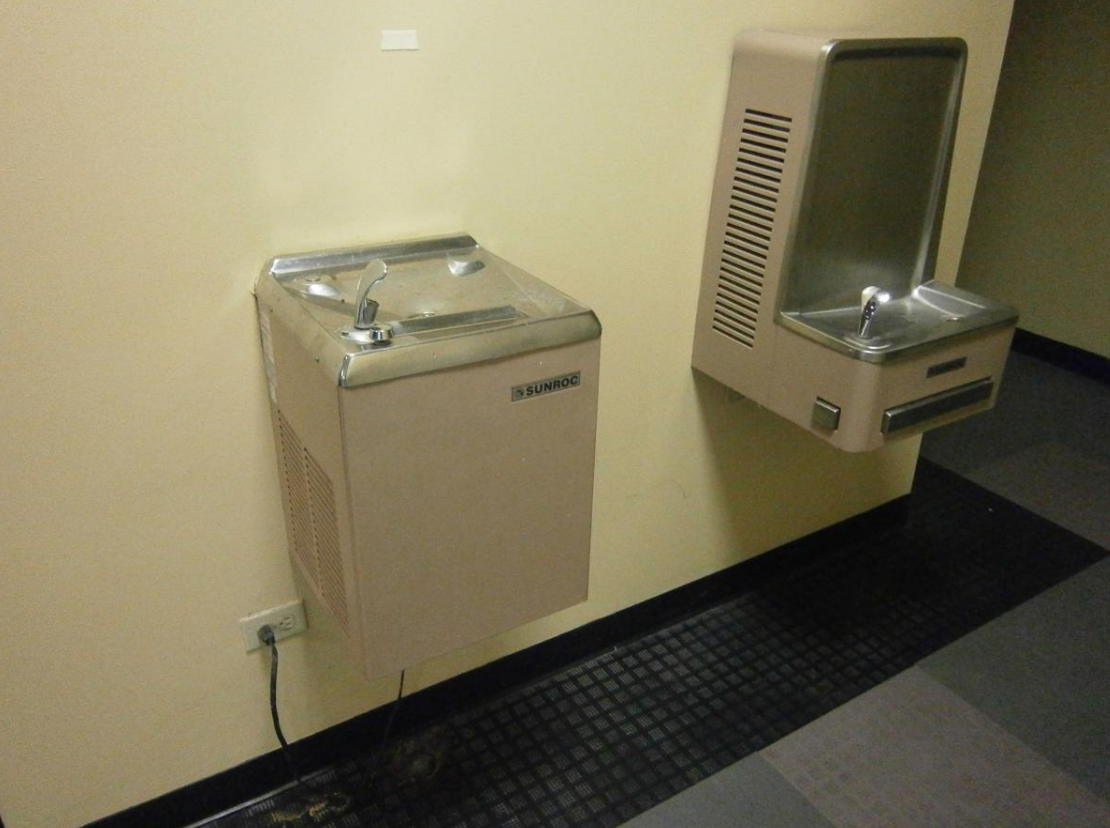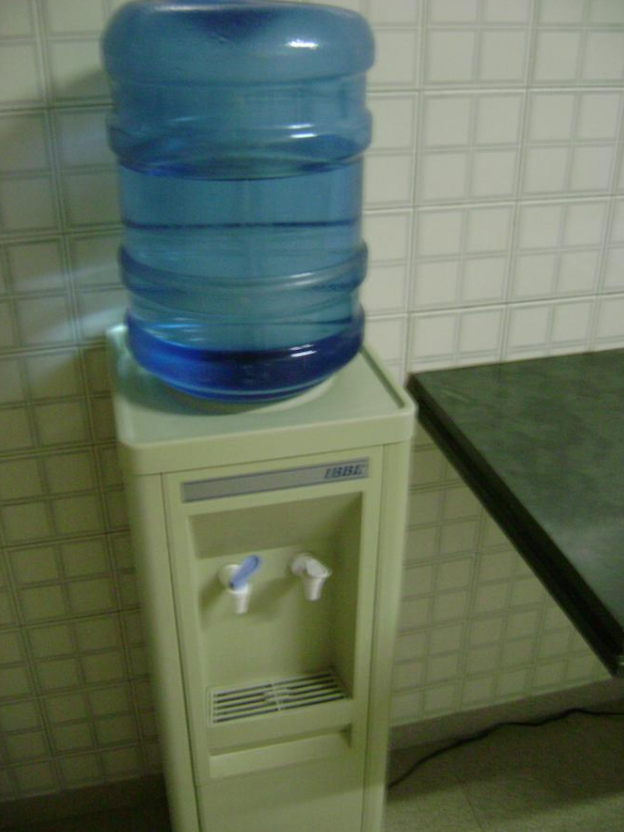A water cooler or water dispenser is a device that cools and dispenses water. Water coolers come in a variety of form factors, ranging from wall-mounted to bottle filler water cooler combination units, to bi-level units and other formats. They are generally broken up in two categories: point-of use (POU) water coolers and bottled water coolers. POU Water coolers are connected to a water supply, while bottled water coolers require delivery (or self-pick-up) of water in large bottles from vendors. Bottled water coolers can be top-mounted or bottom-loaded, depending on the design of the model. Bottled water coolers typically use 5 or 10-gallon dispensers commonly found on top of the unit. Pressure coolers are a subcategory of water coolers encompassing water fountains and direct-piping water dispensers. Water cooler may also refer to a primitive device for keeping water cool. Water coolers are a common metonym referring to workplace socialization.
- socialization
- self-pick-up
- water cooler
1. Dispenser Types

1.1. Wall-Mounted / Recessed
The wall-mounted type is connected to the building's water supply for a continuous supply of water and electricity to run a refrigeration unit to cool the incoming water, and to the building's waste disposal system to dispose of unused water. Wall-mounted water coolers are frequently used in commercial buildings like hospitals, schools, businesses, and other facilities.
In the standard wall-mounted cooler, also commonly referred to as a water fountain or drinking fountain, a small tank in the machine holds chilled water so the user does not have to wait for chilled water. Water is delivered by turning or pressing a button on a spring-loaded valve located on the top of the unit, that turns off the water when released. Some devices also offer a large button on the front or side. Newer machines may not have a button at all; instead, a sensor that detects when someone is near and activates the water. Water is delivered in a stream that arches up, allowing the user to drink directly from the top of the stream of water. These devices usually dispense water directly from the municipal water supply, without treatment or filtering.
Wall mount water coolers come in a wide variety of styles, from recessed models to splash resistant, contoured basins protruding out from the wall, traditional rounded square edge designs, bottle filler and water cooler combination units, bi-level designs, and other features and options.
1.2. Bottom-Load Water Dispenser
Water dispensers commonly have the water supply vessel mounted at the top of the unit. Bottom-load water dispensers have the vessel mounted at the bottom of the unit to make loading easier.
1.3. Tabletop Water Dispenser
There are also smaller versions of the water dispensers where the dispenser can be placed directly on top of a table.
1.4. Direct-Piping Water Dispenser (POU)
Water dispensers can be directly connected to the in-house water source for continuous dispensing of hot and cold drinking water. This type is commonly referred to as POU (Point of Use) water dispensers. These are more hygienic than bottled water coolers [1].

1.5. Freestanding
A freestanding design generally involves bottles of water placed spout-down into the dispensing machine.
Tabletop or kitchen worktop versions are available which utilize readily available five-liter water bottles from supermarkets. These coolers use air pumps to push the water into the cooling chamber and Peltier devices to chill the water.
A new development within the water cooler market is the advent of countertop appliances which are connected to the mains and provide an instant supply of not only chilled water but also hot and boiling water. This is often visible in the horeca industry.
Water will flow faster when the handle is in the upright position. The water is aerated which allows the water to come through the spout at a faster rate.
2. Water Source and Purification
2.1. Bottle
To install the bottle, the bottle is tipped upside down and set onto the dispenser; a probe punctures the cap of the bottle and allows the water to flow into the machine's internal reservoir. These gravity-powered systems have a device to dispense water in a controlled manner.
These machines come in different sizes and vary from table units, intended for occasional use to floor-mounted units intended for heavier use. Bottled water normally is delivered to the household or business on a regular basis, where empty bottles are exchanged for full ones. The bottle size varies with the size of the unit, with the larger versions in the US using 5-US-gallon (19 L) bottles. This is also the most common size elsewhere, labelled as 18.9 litres in countries that use the metric system. These units usually do not have a place to dump excess water, only offering a small basin to catch minor spills. On the front, a lever or pushbutton dispenses the water into a cup held beneath the spigot.
When the water container is empty, it is lifted off the top of the dispenser, and automatically seals to prevent any excess water still in the bottle from leaking.
2.2. Plumbed with Purification
Plumbed water coolers use tap water and therefore do not need bottles due to their use of the main water supply. Usually some method of purification is used.
2.3. Filtration
Filtration methods include reverse osmosis, ion exchange and activated carbon.
3. Cooling and Heating Methods
3.1. Cooling
Most modern units offer a refrigeration function to chill the water, using Vapor compression refrigeration or Thermoelectric cooling.
Vapor compression refrigeration
Water coolers using vapor compression refrigeration are made up of the following components:
- Reservoir
- RR technology is a removable reservoir is an open-end tank with cooling coils that come into contact with the external tank surface. It operates on the basis of a modular system, allowing one to easily detach and refill water instead of keeping it in a closed system. One of the advantages in using a removable reservoir is the ease of sanitization. This allows end users to replace the reservoir completely rather than sending an entire water cooler back for servicing. A similar technology can be found in many modern water dispensers and coffee machines.
- Stainless Steel - open end tank with cooling coils that come into contact with the external tank surface
- Pressure cooling tank - A closed pressurized tank with external cooling coil that comes in contact with the tank surface
- Ice-bank - A pressurized water coil pipe that sits in a volume of pre-chilled water
3.2. Heating
Some versions also have a second dispenser that delivers room-temperature water or even heated water that can be used for tea, hot chocolate or other uses. The water in the alternate hot tap is generally heated with a heating element and stored in a hot tank (much like the traditional hot water heaters used in residential homes). Additionally, the hot tap is usually equipped with a push-in safety valve to prevent burns from an accidental or inadvertent pressing of the lever.
4. Recent Developments
Modern variants of water coolers have been equipped with options for carbonated water as a result of increasing demand for carbonated beverages and also a greater awareness to healthy living, resulting in preference for carbonated water over sweetened carbonated beverages.[2] Newer variants of water coolers have also been spotted in public places such as airports[3][4] and railway stations[5], where a bottle filling unit is installed indicating the number of single-use plastic bottles saved as part of an ongoing public effort to reduce plastic pollution.
5. Water Cooler Effect
A water cooler effect is a phenomenon, occurring when employees at a workplace gather around the office water cooler and chat.[6] It is a synonym for gathering and connecting people in a certain environment (e.g. the office). When a television program, like a soap-opera or series, is talked about among many people (mostly related to guessing what will happen in the next episode) it can be said that the program has a water cooler effect.
The content is sourced from: https://handwiki.org/wiki/Engineering:Water_cooler
References
- "Water Coolers and Ice - Making Machines Policy". Royal Devon and Exeter NHS Foundation Trus. 2015-01-13. http://www.rdehospital.nhs.uk/docs/patients/services/infection_control/water-coolers-and-ice-making-machines.pdf. Retrieved 2018-02-25.
- Team, Trefis (2014-01-14). "Coca-Cola Eyes Growth In The Sparkling Bottled Water Market". https://www.forbes.com/sites/greatspeculations/2014/01/14/coca-cola-eyes-growth-in-the-sparkling-bottled-water-market/#495b6d2a699f.
- Yamanouchi, Kelly (2013-06-21). "Water bottle filling stations coming to airport". https://www.ajc.com/business/water-bottle-filling-stations-coming-airport/3Y6RKtDqzs8TBJWIqYTqBO/.
- Brockman, Joshua (2017-11-20). "Instead of That $5 Water Bottle at Airports, Filling Stations". https://www.nytimes.com/2017/11/20/business/water-bottle-airports-filling-stations.html.
- "Scotland's railway stations to offer drinking water". 2018-01-25. https://www.bbc.com/news/uk-scotland-42818453.
- "Deciphering the Watercooler Effect | Research | RIT". https://www.rit.edu/research/feature/may-2010/deciphering-watercooler-effect.
